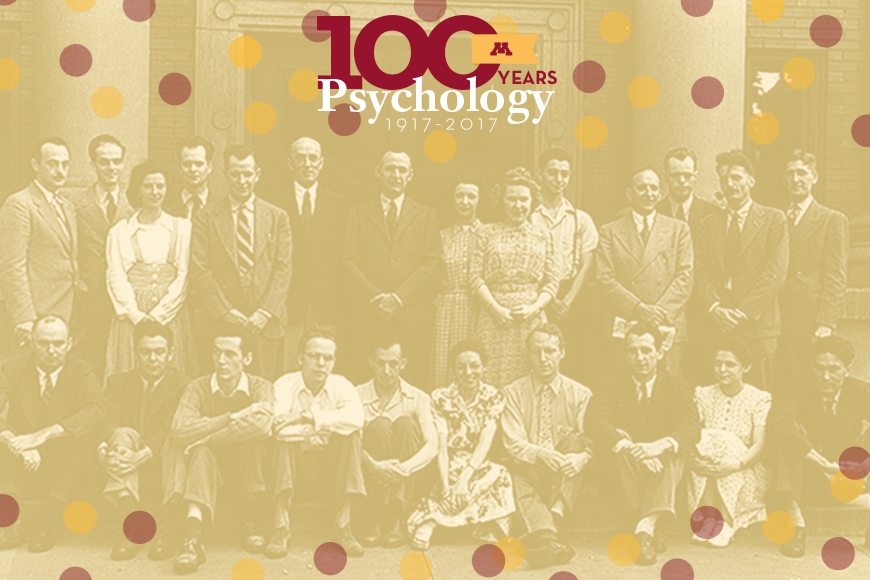100 Years of Excellence
On May 19, 1917, the Department of Psychology was established at the University of Minnesota. At the time Freud’s most popular lecture series, Introduction to Psychoanalysis, was newly published, and the University of Minnesota campus had just split apart the departments of psychology and philosophy. One hundred years later, the field has transformed -- and the department along with it.
Professors Andrew Oxenham and Eugene Borgida, along with department chair Monica Luciana, share some of the department’s history as they celebrate their anniversary and look to the future.
History & Prominence in the Field
The department’s long history is filled with distinguished faculty and graduates who have contributed to cutting-edge research. “Probably the most famous [is] B.F. Skinner, who I think did all his best work while he was still here, at Minnesota,” says Distinguished McKnight University Professor Andrew Oxenham. He is also the area director for cognitive and brain science.
Skinner was an instructor at the University of Minnesota from 1936 to 1945, and in 2002 was named number one on the list of the 100 most eminent psychologists of the 20th century.
“He’s famous in the field of behaviorism,” says department chair Monica Luciana of Skinner’s work. “The idea behind behaviorism is that you can change someone’s behavior just by managing contingencies and feedback associated with what people do. So, the ideas behind motivations don’t really matter so much. That was a revolutionary concept for its time.”
Another notable figure from the department is Paul Meehl, who both studied and instructed at the University of Minnesota for the majority of his life. He was affiliated with the clinical psychology program and became famous in the field for his writings on statistical prediction versus clinical prediction.
“How do you predict people’s future behavior? And can you do that more on the basis of your impressions of a person and interviewing them and gathering information or using a more data-driven kind of approach?” says Luciana. “[Meehl] ultimately was more in favor of the data-driven approach, and he wrote quite a bit about the classification of psychopathology. So, how we understand different disorders and how they’re related to one another. He’s one of the most famous clinical psychologists ever in our history, and his whole career was here.”
Skinner and Meehl are examples of the research excellence the department strives for.
“Throughout the existence of the department, one thing that [has] set us apart is the focus on quantitative research,” says Oxenham. “Not being satisfied with qualitative reports, but using math and more quantitative models to derive a better understanding.”
Eugene Borgida, professor of psychology and law, sees the department’s passion for research as a draw for its many undergraduates. “Psychology as an undergraduate major is one that gives you very good skills at generating evidence, collecting data, and thinking about questions in society from an evidence-based perspective,” he says. “So, it’s a rigor of training that I think appeals to a lot of students.”
And he means a lot of students.
The Department Today
Today, psychology is the most popular undergraduate major in the College of Liberal Arts with nearly 1,500 undergraduates. Faculty members point to a variety of factors that bolster their department’s reputation and attract students.
“There’s a commitment to excellence,” Borgida continues. “There’s a commitment to producing outstanding students. We all take great pride when our students get jobs -- and good jobs. The thing that’s remarkable about this department is the longevity of its outstanding reputation.”
Luciana also believes there’s a distinct reputation that is attached to the department; one that both invites and motivates undergraduates.
“There is kind of a Minnesota signature that has underpinned a lot of what the department has done,” Luciana says. “[Students] understand the foundation that we’re built on. And I think they ... feel like they’re joining something great when they come here. And that inspires them to do their best work.”
The department stands out not only for its research and reputation, but for the way it’s structured. For example, the child psychology program -- number one in the nation -- exists not only as its own separate department, but in an entirely different college: the College of Education and Human Development.
“You could almost say we have multiple psychology departments here,” Luciana comments.
“That’s another thing that maybe sets us apart from many other psychology departments,” adds Oxenham. “We’re quite large. We have over forty faculty members. And we do represent a very broad range of disciplines within psychology. We [also] have this amazing facility that has world-leading technical expertise in neuroimaging using functional magnetic resonance imaging. We currently have the largest magnet that’s used for human scanning in the world.”
This range of disciplines allows for the department to collaborate with a variety of outside groups.
“Psychology is a discipline that intersects comfortably with almost every other discipline, and that’s something even within the university that we value: our ability to make connections with other units and with other disciplines,” Luciana says.
What’s to Come
“As the field evolves, we want to evolve too,” Luciana continues, looking to the future. “And we would strive to, either among our current faculty or people we would hire, to stay on top of important changes in the field.”
Oxenham hopes the department maintains its long reputation of being ranked as one of the top ten psychology departments in the nation.
“What I’d hope for the department is that we are able to continue attracting the best faculty from all over the world to do their research here,” he says, “And the best students from all over the world to study here.”



